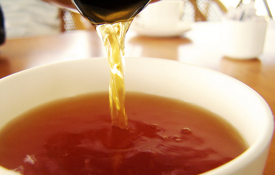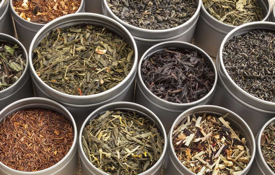
Many Start Their Day with Fresh Brewed Tea
Tea is the world’s most popular beverage next to water and has been consumed for nearly 5,000 years. While tea consumption in the US is slight when compared to Asia, Ireland, and the UK, 80% of all US households have tea in their cabinet. According to the Tea Association of the USA, Americans consumed more than 3.8 billion gallons of tea in 2018. About 84% of all tea consumed was Black Tea, 15% was Green Tea, and the small remaining amount was Oolong. On a daily basis 159 million Americans will consume tea.
With so many tea drinkers in the US why is tea service is restaurants and cafes so poor? Coffee service is near the bottom of the typical restaurant’s priority list, tea barley rates a thought. Many restaurant operators will tell you that there is simply not much call for tea. True but how many customers would order the soup of the day if their request was greeted with a bowl of hot water and a bouillon cube? Sadly, tea is most frequently served in this manner.
Lose the Tea Bag
While tea is truly an ancient beverage, the teabag is a relatively new adaptation in service. The first tea bag was believed to be the creation of New York tea merchant Thomas Sullivan in 1904. While the innovation made it easy for tea drinkers to enjoy their favorite brew with ease, today’s commercial tea bags are filled with the lowest grades of tea; fannings and dust (yes, these are actual grades used by tea professionals). The bottom line is that if you have drunk tea solely from the teabag, you haven’t really had tea.
Tea Types
Black teas are the strongest of the teas. Black teas are intentionally allowed to oxidize (often called “fermentation” by tea merchants although it is not a true fermentation) for a period of roughly four hours. This process allows the chlorophyll to break down and release natural tannins and flavor compounds not found in green tea leaves.
Green and white teas are dried rather quickly after being picked to assure that oxidation does not take place. This is achieved by a process known as firing where extremely hot air is blasted through the leaves preserving much of their fresh character.

Tea Has Many Grades, Colors, and Leaf Sizes
Oolong teas are partially oxidized, for roughly two hours, before being dried thus halting this natural occurrence. This technique produces a style that is a mid-way point between green and black teas having the fresh and grassy green qualities of green tea while possessing some of the depth in both color and flavor found in black teas.
Caffeine in tea varies from variety to variety but generally speaking black teas have the highest levels of caffeine while green has the lowest with oolong lying somewhere between.
Tea Preparation and Service
Brewing tea is a simple process but it does require you to be aware of the variety of tea being served. At home or in a restaurant setting the standard 16 oz. ceramic teapot is the ideal tea service vehicle. Simple teapots are relatively inexpensive and they are dishwasher safe. Many teapots are fitted with a wire mesh insert designed to keep the tea leaves from pouring in to the cup. This also makes for fast and easy clean-up.
Whatever you choose, do not use a French Press or any other vessel once used for coffee! Coffee flavors are easily embedded in the pot or press and will seriously taint the tea. You need not have a super palate to detect the residual coffee aromas and flavors so keep coffee away from your tea equipment.
Once your teapots are secured the only other required hardware is a kettle or hot water source capable of providing boiling water. The common counter-top electric kettle is an easy and inexpensive solution.
Black tea is best produced with water at, or near, boiling temperature to activate the essential oils and release flavors and aromas created during oxidation. To get the best extraction, heating the teapot with a hot water rinse prior to brewing is advised as this slows the inevitable temperature drop. The ideal steeping time varies from one tea to another, and your tea merchant will provide this information. Two minutes is a median to low brewing time while many black teas prefer four minutes.
Green teas are absolutely wrecked by boiling water, preferring water at roughly 180° F. Don’t feel the need to get your thermometer out for each serving as simply pouring nearly boiling water in to a cool teapot, adding a shot of cold water and allowing it sit for a brief moment will get you to the desired temperature. Oolong, being in the middle, prefers a water temperature between green and black, roughly 190° F but it will not suffer much from hotter temperatures.
Tea Additions
Just like coffee, tea is served straight or with the addition of sugar, milk, and citrus. Dedicated tea drinkers with a sweet tooth prefer white candy sugar as it brings sweetness without any robust flavors that may overshadow the subtle nuances of the tea. Some prefer the addition of milk or cream to tea but this is most often used with the darkest and most assertive black teas. For me, I like my tea with nothing but a cup.
Tea for Health
The healthy attributes of tea drinking are being revealed regularly contributing greatly to American’s rapidly growing tea consumption. Tea contains flavonoids that are naturally occurring compounds believed to have antioxidant properties. As health conscious Americans know, antioxidants work to neutralize free radicals in the body and help shield us from chronic disease. Antioxidants have been shown in studies to inhibit the growth of cancerous cells and support cardiovascular health. This is a good thing. Tea has also been shown to lower LDL cholesterol, reduce the risk of colon cancer, and improve bone density in female tea drinkers.
